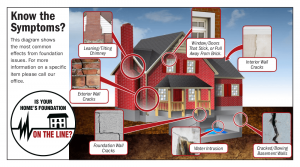Foundation Repair

Water is a common cause of foundation repair. Poor drainage, negative grading, and rising groundwater create soil movement, slab cracking, wall displacement, and interior finish damage. If you’re seeing early warning signs, act before costs multiply.
Foundation Repair Warning Signs
- Hydrostatic pressure: saturated soil pushes laterally on walls, causing cracking/bowing.
- Soil erosion & voids: flowing water carries fines away, leading to settlement.
- Slab distress: heave and cracking from moisture changes beneath concrete.
- Finish damage: warped floors, peeling paint, efflorescence, and mold from high humidity.
External reference: USGS groundwater levels (Florida).
Foundation Damage Warning Signs (Checklists)
Interior (1–7 quick checks)
- Doors/windows stick or won’t latch
- Cracks in floors, drywall, or ceilings
- Uneven/sloping floors
- Baseboards or crown pulling away
- Musty odors, water stains, or visible mold
- Efflorescence on tile/concrete
- Bowing/leaning interior walls
Exterior (1–7 ground checks)

- Foundation/brick/masonry cracks
- Gaps around windows/doors
- Tilting chimney or garage columns
- Standing/flowing water near the foundation
- Negative grade toward the house
- Spalling/chipping concrete
- Mildew growth along the base of walls
If you note 2+ items in either list, schedule an inspection.
Timeline of Damage Progression
- 0–24 hours: heavy rain elevates soil moisture; hydrostatic pressure spikes.
- 1–7 days: minor leaks, hairline cracks, doors begin to bind.
- 30–90 days: settlement/heave becomes measurable; interior finishes deteriorate.
- 6–12 months: structural movement locks in; repair scope and cost increase.
Engineering-Led Foundation Repair for Florida’s Water Challenges
Florida’s high water table, flat terrain, and intense seasonal rain mean foundations fail differently here than in most of the country. Our team, led by water hydraulics engineer Jeff Earl, begins every repair by solving the water problem first — controlling hydrostatic pressure, redirecting drainage, and stabilizing soils before structural work begins. This approach prevents repeat movement and ensures long-term performance.
Protecting Value & Avoiding Escalating Costs
Ignoring early warning signs can allow 2–3 inches of settlement within a decade and speed up steel corrosion by up to 40%. Once movement “locks in,” piering or grouting scopes expand and costs rise quickly. Our engineered foundation repair solutions stop water-driven soil loss, re-support slabs and footings, and are backed by a Lifetime Transferable Warranty to protect both your structure and its resale value.
Our Engineered Solutions
- Piering systems: stabilize foundations and detect subsurface voids during installation.
- Pressure grouting: fill/bridge voids now or years later to re-support soils.
- Drainage engineering: regrade, collect, and discharge water away from the structure.
- Waterproofing assemblies: protect slabs, walls, and interior finishes long-term.
Next Steps
- Review your warning-sign checklists above.
- See local groundwater context: USGS Florida GW levels.
- Book your FREE inspection to prevent escalating damage and cost.
Florida Foundation Repair — Frequently Asked Questions
Does the Florida Building Code require below-grade waterproofing for foundations?
No. The Florida Building Code (FBC) does not include dedicated standards for below-grade waterproofing. Because the state sits on a naturally high water table, foundations must often be designed as if you’re “building a boat” underground to resist hydrostatic pressure — but this is not stated in the code.
Do I need a building permit to repair or waterproof a foundation in Florida?
Only if structural changes are made. Drainage systems, sump pumps, and standard waterproofing work do not require a permit. Structural modifications — such as reinforcing or rebuilding walls or installing deep foundation elements — trigger permitting with local building departments.
How much can professional foundation repair and waterproofing cost?
Comprehensive water-driven foundation repair in Florida typically ranges from $20,000–$40,000, depending on groundwater depth, soil type, and required stabilization. Acting early before major movement occurs can help keep costs lower.
Can a Florida foundation stay stable long-term despite high groundwater?
Yes — if water is controlled first. Successful long-term repairs pair engineered drainage, waterproofing membranes, and, where necessary, structural supports such as piers or pressure grouting. With the right design, a Florida foundation can remain dry and structurally sound even in saturated soils and heavy storm cycles.
What are the early warning signs of foundation damage?
Interior: doors sticking, drywall cracks, sloping floors, and musty odors.
Exterior: cracks in masonry, tilting chimneys, pooling water, and negative grading.
How fast can foundation damage progress?
Within 24 hours of heavy rain, soil pressure spikes; within a week, cracks and binding doors appear; within 90 days, measurable settlement and finish deterioration occur. By 6–12 months, structural movement “locks in” and repair costs escalate.
